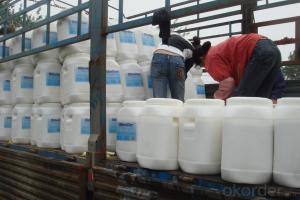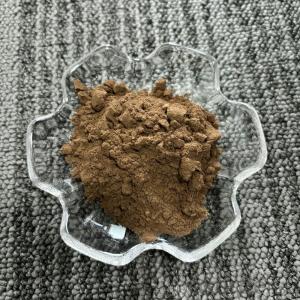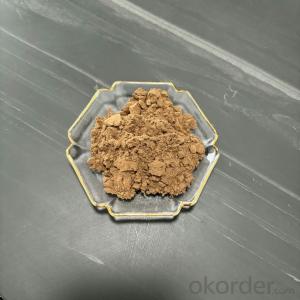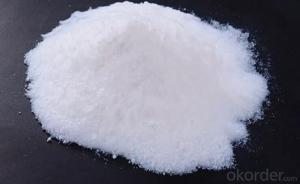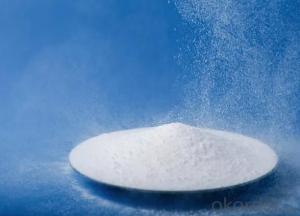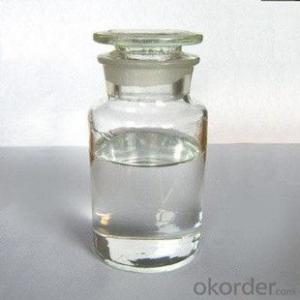Calcium Hypochlorite Water treatment Granular
- Loading Port:
- Tianjin
- Payment Terms:
- TT OR LC
- Min Order Qty:
- -
- Supply Capability:
- 6000 m.t./month
OKorder Service Pledge
OKorder Financial Service
You Might Also Like
Calcium Hypochlorite
Introduction:
CNBM GROUP is the biggest water Treatment Factory in China. Our Product include: Calcium Hypochlorite, TCCA, SDIC, PAC, Sodium Sulphite, Sodium Thiosulfate etc.
CNBM One year can produce 18,000MT Calcium Hypochlorite with two model, one is 65% and one is 70%. More important we have 3 advantages, Firstly: High effective chlorine content Secondly: Good stability. Can be stored a long time at normal temperature with little chlorine loss; Third:Good solubility, less water-insoluble matters.
Technical Specifications:
Calcium Hypochlorite 65%
Index Name | Top Grade | First Grade |
Chlorine Content ≥ | 65% | 60% |
Moisture ≤ | 3% | 3% |
Yearly Loss of Active Chlorine | 8% | 8% |
Calcium Chloride | 9% | 10% |
Color | White or Light-grey | ----- |
Shape | Power & Granular |
|
Calcium Hypochlorite 70%
Index Name | Top Grade | First Grade | Quality Product |
Chlorine Content ≥ | 70% | 67% | 65% |
Granularity(14-50 mesh)% ≥ | 90 | 87 | 87 |
Moisture % | 5.5~10 |
|
|
Tablets Forms
Weight | 200 gram | 150gram | 100gram | 50gram | 30gram | 20gram | 15gram | 10gram |
Diameter(mm) | 76 | 70 | 50 | 42 | 30 | 30 | 30 | 30 |
Height(mm) | 25 | 21 | 26 | 27 | 22 | 16 | 12 | 8 |
Applications:
1. For bleaching purpose of wood pulp, silk, cloth and fibre.
2. Disinfection and water-treatment.
3. Disinfectant for chemical poisonous and radioactive substance.
Formula Experiment Design: (Base on 1MT Water)
Constitue Dosage
Calcium Hypochlorite 65% 100kg
Disinfection Liquid 1% Calcium Hypochlorite 65% 1.7g
Shipping Containers:
45—50kg Plastic or Steel Drums with Inner Plastic Bag.
Cautions
1. Should be stored in cool and dry warehouse away from heating sources and avoid direct sunlight.
2. In transportation, contact with such should be avoided as sunlight, heating,moisture, organics, oil and acids.
Other Information please check the MSDS.
- Q:a) A catalyst such as chlorophyll must be present for some reactions to take place.b) A catalyst such as chlorophyll is not one of the products of a chemical reaction.c) A catalyst such as chlorophyll is not a substance that is used or changed in a chemical reaction.
- Perky, I doubt that it would be B because everything could be said to be the result of a chemical reaction. I think the answer is C because you could paraphrase it to say; chlorophyll is a substance that does not participate in any chemical reactions, which is of course, not true.
- Q:Does a catalyst work for both reactants and products?From my understanding, organic catalyst or enzyme does not necessarily work for the product of the reaction because of the shape of the activation site. However I cannot speak for inorganic ones.
- A catalyst works for either the reactants or the product in a given reaction. If it works for the reactants then the activation site on the enzyme, for example, will only fit on the reactants. If a catalyst is added to a reaction in which it catalyzes the back-reaction, or it aids the products, then the reaction will be reversed. i don't think a catalyst could work for both the reactants and products in one reaction because it wouldn't really be a catalyst anymore; it wouldn't make the rxn progress any faster since it would be canceling out itself by aiding both the reactants and the products. I think this is what you are asking, if not please post more details. I hope I didn't confuse you even more!
- Q:Is palladium predominantly a catalyst in chemistry?
- Palladium in the chemical mainly to do the catalyst; palladium and ruthenium, iridium, silver, gold, copper and other alloy, can improve the palladium resistivity, hardness and strength, used in the manufacture of precision resistors, jewelry and so on.
- Q:Could you tell me all the differences between those two catalysts? Thank you very much.
- Biological catalyst: 1. Biological catalysts or enzymes are high molecular weight globular proteins. 2.Their composition may change at the end of reaction. 3.Their catalyzing effect is very high. i.e faster than chemical catalyst. 4.They are reaction specific. i.e One enzyme or biological catalyst may catalyze only particular type of reaction and not many. 5.They are intolerant to temperature and pH changes. An enzyme can not function outside its temperature or pH range. e.g amylase,lipase,pepsin Chemical catalyst: 1.Chemical catalysts are simple inorganic molecules with low molecular weight. 2.They remain unchanged at the end of reaction. 3.They are slower compared to enzymes. 4.They are not reaction specific. 5.They function within wide range of temperatures,pH or pressure. e.g vanadium dioxide, platinum
- Q:Chemical master invited (about catalyst)
- From the thermodynamics can be reaction, and the three formulas can be added to eliminate the intermediate product, indicating that the reaction may occur. The definition of the catalyst is not complete. I am a junior undergraduate student of Jilin University School of Chemistry, according to the definition of the catalyst in the university textbook, the catalyst itself reacts with the reactants to produce unstable intermediates. After the reaction is finished, the intermediate product is explained and the catalyst is reduced. Apparently did not participate in the reaction. So the catalyst to change the course of the reaction, the original reactants to go through a relatively high energy to produce products, there will be a catalyst after a few relatively low energy barrier, so much easier, the reaction rate is greatly accelerated The It can be seen, the catalyst is not no response, but only after the completion of the reaction to restore it. It can also be seen that the amount of catalyst does not matter, and some reactions require the amount of catalyst to be approximately equal to the amount of reactants. Waiting for you to high school and university to further study on this issue will have a more clear understanding of the.
- Q:Can a catalyst decrease the rate of a chemical reaction? Please give an example if yes.
- A catalyst is something that quickens the fee of reaction without getting used up itself. They many times try this by skill of lowering the activation skill, which additionally brings the optimal temperature down. So, to place it only, it relatively is B.
- Q:Are biological enzymes harmful to humans?
- Biological enzymes through scientists more than a century of research, usually known as more than 3,000 kinds of enzymes, the current application of biological enzymes in the textile a wide range of technology, fiber modification, silk degumming, raw hemp (ramie, linen, Kenaf) degumming, dyeing and finishing of the desizing, refining, finishing and net cleaning processing, textile printing and dyeing wastewater treatment and garment processing and other aspects of the application. Enzyme technology has a unique advantage in improving dyeing and finishing processes, saving energy, reducing environmental pollution, improving product quality, adding value and developing new raw materials. At present in the textile processing using a wide range of enzyme preparations are mainly cellulase, protease, amylase, pectinase, lipase, peroxidase, laccase, glucose oxidase eight categories.
- Q:How does the catalyst affect chemical balance? Why the catalyst has no effect on the chemical equilibrium, for v-t diagram
- The catalyst only affects the time required to reach equilibrium and does not affect the conversion of the reactants
- Q:what is the difference between enzyme and catalyst?
- Enzymes and catalysts both affect the rate of a reaction. The difference between catalysts and enzymes is that while catalysts are inorganic compounds, enzymes are largely organic in nature and are bio-catalysts. Even though all known enzymes are catalysts, all catalysts are not enzymes. Moreover, catalysts and enzymes are not consumed in the reactions they catalyze. Catalysts are low molecular weight componds, enzymes are high molecular globular proteins. Catalysts are inorganic, enzymes are organic. Catalyst reaction rates are slower (usually) than enzyme reaction rates. Catalysts are not generally specific - enzymes are VERY specific. Catalysts increase or decrease the rate of a chemical reaction, enzymes are proteins that incrase the rate of chemical reactions & convert the substrate into product. There are 2 types of catalysts - (positive & negative), and the 2 types of enzymes are activation enzymes and inhibitory enzymes. Catalysts are simple inorganic molecules, while enzymes are complex proteins.
- Q:describe a biological catalyst?
- A biological catalyst is a subclass protein called an enzyme. Enzymes are biological catalysts that increase the rate of chemical reactions. A catalyst does the following: 1) Increases the rate of reaction 2) Is not itself changed at the end of the reaction 3) Does not change the reaction or its final result The amount of energy required for this reaction is called activation energy. The enzyme lowers the activation energy necessary for the reaction to take place, thus speeding up the process.
1. Manufacturer Overview |
|
|---|---|
| Location | |
| Year Established | |
| Annual Output Value | |
| Main Markets | |
| Company Certifications | |
2. Manufacturer Certificates |
|
|---|---|
| a) Certification Name | |
| Range | |
| Reference | |
| Validity Period | |
3. Manufacturer Capability |
|
|---|---|
| a)Trade Capacity | |
| Nearest Port | |
| Export Percentage | |
| No.of Employees in Trade Department | |
| Language Spoken: | |
| b)Factory Information | |
| Factory Size: | |
| No. of Production Lines | |
| Contract Manufacturing | |
| Product Price Range | |
Send your message to us
Calcium Hypochlorite Water treatment Granular
- Loading Port:
- Tianjin
- Payment Terms:
- TT OR LC
- Min Order Qty:
- -
- Supply Capability:
- 6000 m.t./month
OKorder Service Pledge
OKorder Financial Service
Similar products
New products
Hot products
Hot Searches
Related keywords
